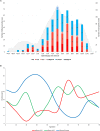Clinical and molecular epidemiology of influenza viruses from Romanian patients hospitalized during the 2019/20 season
- PMID: 34767579
- PMCID: PMC8589178
- DOI: 10.1371/journal.pone.0258798
Clinical and molecular epidemiology of influenza viruses from Romanian patients hospitalized during the 2019/20 season
Abstract
Two main mechanisms contribute to the continuous evolution of influenza viruses: accumulation of mutations in the hemagglutinin and neuraminidase genes (antigenic drift) and genetic re-assortments (antigenic shift). Epidemiological surveillance is important in identifying new genetic variants of influenza viruses with potentially increased pathogenicity and transmissibility. In order to characterize the 2019/20 influenza epidemic in Romania, 1042 respiratory samples were collected from consecutive patients hospitalized with acute respiratory infections in the National Institute for Infectious Diseases "Prof. Dr. Matei Balș", Bucharest Romania and tested for influenza A virus, influenza B virus and respiratory syncytial virus (RSV) by real-time PCR. Out of them, 516 cases were positive for influenza, with relatively equal distribution of influenza A and B. Two patients had influenza A and B co-infection and 8 patients had influenza-RSV co-infection. The most severe cases, requiring supplemental oxygen administration or intensive care, and the most deaths were reported in patients aged 65 years and over. Subtyping showed the predominance of A(H3N2) compared to A(H1N1)pdm09 pdm09 (60.4% and 39.6% of all subtyped influenza A isolates, respectively), and the circulation of Victoria B lineage only. Influenza B started to circulate first (week 47/2019), with influenza A appearing slightly later (week 50/2019), followed by continued co-circulation of A and B viruses throughout the season. Sixty-eight samples, selected to cover the entire influenza season and all circulating viral types, were analysed by next generation sequencing (NGS). All A(H1N1)pdm09 sequences identified during this season in Romania were clustered in the 6b1.A clade (sub-clades: 6b1.A.183P -5a and 6b1.A.187A). For most A(H1N1)pdm09 sequences, the dominant epitope was Sb (pepitope = 0.25), reducing the vaccine efficacy by approximately 60%. According to phylogenetic analysis, influenza A(H3N2) strains circulating in this season belonged predominantly to clade 3C.3A, with only few sequences in clade 3C.2A1b. These 3C.2A1b sequences, two of which belonged to vaccinated patients, harbored mutations in antigenic sites leading to potential reduction of vaccine efficacy. Phylogenetic analysis of influenza B, lineage Victoria, sequences showed that the circulating strains belonged to clade V1A3. As compared to the other viral types, fewer mutations were observed in B/Victoria strains, with limited impact on vaccine efficiency based on estimations.
Conflict of interest statement
OS, Anca S-C, and Adrian S-C report being investigators in influenza clinical trials by Shionogi and F. Hoffmann-La Roche, outside the scope of the submitted work. No other authors have competing interests to declare.
Figures





Similar articles
-
Antigenic Drift of A/H3N2/Virus and Circulation of Influenza-Like Viruses During the 2014/2015 Influenza Season in Poland.Adv Exp Med Biol. 2016;905:33-8. doi: 10.1007/5584_2016_216. Adv Exp Med Biol. 2016. PMID: 26956457 Free PMC article.
-
Resurgence of influenza with increased genetic diversity of circulating viruses during the 2022-2023 season.J Med Microbiol. 2024 Jul;73(7). doi: 10.1099/jmm.0.001864. J Med Microbiol. 2024. PMID: 39073070
-
Predominance of influenza A(H3N2) viruses during the 2016/2017 season in Bulgaria.J Med Microbiol. 2018 Feb;67(2):228-239. doi: 10.1099/jmm.0.000668. Epub 2018 Jan 3. J Med Microbiol. 2018. PMID: 29297852
-
Vaccination and antigenic drift in influenza.Vaccine. 2008 Jul 18;26 Suppl 3(Suppl 3):C8-14. doi: 10.1016/j.vaccine.2008.04.011. Vaccine. 2008. PMID: 18773534 Free PMC article. Review.
-
A decade genetic diversity in Circulating influenza B virus in Iran (2010-2019): Divergence from WHO-recommended vaccine strains.Vopr Virusol. 2023 Nov 7;68(5):385-393. doi: 10.36233/0507-4088-180. Vopr Virusol. 2023. PMID: 38156573 Review.
Cited by
-
Age, comorbidity burden and late presentation are significant predictors of hospitalization length and acute respiratory failure in patients with influenza.Sci Rep. 2024 Jul 6;14(1):15563. doi: 10.1038/s41598-024-66550-8. Sci Rep. 2024. PMID: 38971866 Free PMC article.
-
The Impact of Obesity on the Host-Pathogen Interaction with Influenza Viruses - Novel Insights: Narrative Review.Diabetes Metab Syndr Obes. 2024 Feb 13;17:769-777. doi: 10.2147/DMSO.S434115. eCollection 2024. Diabetes Metab Syndr Obes. 2024. PMID: 38371386 Free PMC article. Review.
-
Occurrence of acute otitis and sinusitis in patients hospitalized for influenza.Germs. 2024 Mar 31;14(1):38-44. doi: 10.18683/germs.2024.1416. eCollection 2024 Mar. Germs. 2024. PMID: 39169978 Free PMC article.
-
From COVID-19 to Influenza-Real-Life Clinical Practice in a Pediatric Hospital.Diagnostics (Basel). 2022 May 12;12(5):1208. doi: 10.3390/diagnostics12051208. Diagnostics (Basel). 2022. PMID: 35626363 Free PMC article.
-
Genome characterization of influenza A and B viruses in New South Wales, Australia, in 2019: A retrospective study using high-throughput whole genome sequencing.Influenza Other Respir Viruses. 2024 Jan;18(1):e13252. doi: 10.1111/irv.13252. Influenza Other Respir Viruses. 2024. PMID: 38288510 Free PMC article.
References
-
- World Health Organization. Recommended composition of influenza virus vaccines for use in the 2021–2022 northern hemisphere influenza season 2021 [cited 2021, Apr 9]]. Available from: https://www.who.int/publications/i/item/recommended-composition-of-influ....
-
- Suntronwong N, Klinfueng S, Korkong S, Vichaiwattana P, Thongmee T, Vongpunsawad S, et al.. Characterizing genetic and antigenic divergence from vaccine strain of influenza A and B viruses circulating in Thailand, 2017–2020. Sci Rep. 2021;11(1):735. Epub 2021/01/14. doi: 10.1038/s41598-020-80895-w - DOI - PMC - PubMed
Publication types
MeSH terms
Substances
LinkOut - more resources
Full Text Sources
Medical
Research Materials

